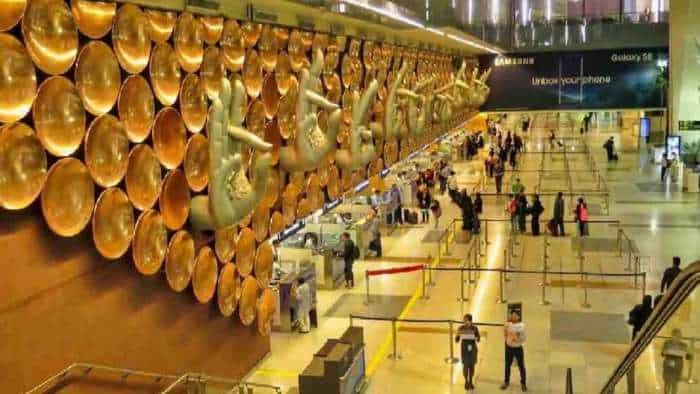Supreme Court's verdict on Essar Steel settles questions related to IBC: Rajnish Kumar, Chairman, SBI
Rajnish Kumar, Chairman, State Bank of India (SBI), talks about growth rate and its impact on the bank and economy, expected recoveries, Jet Airways, NPA levels and challenges being faced by the banks during a candid chat with Swati Khandelwal, Zee Business.

Rajnish Kumar, Chairman, State Bank of India (SBI), talks about growth rate and its impact on the bank and economy, expected recoveries, Jet Airways, NPA levels and challenges being faced by the banks during a candid chat with Swati Khandelwal, Zee Business.
Edited Excerpts:
Q: Talk about the impact that the growth rate of 4.5% will have on the economy and the banking sector?
A: Two things are there (i) slowdown in growth rate, which is a matter of concern and (ii) the trend of private sector investment and there is a need to focus on it. Gross Capital Formation numbers are not quite good. Possibly it is happening due to seasonality like the uneven monsoon in the September quarter has an impact on construction activity and auto sales. The GST collection numbers of October and the overall change in the credit growth in the consumer finance side has been better than the numbers of August and September numbers. Even the mood and sentiment are better now when compared to August and September. Consumer demand and investment both depend on sentiment.
Besides, several steps are being taken like government moved ahead and provided a deferment of two years on spectrum charges to end the concerns of the telecom sector. And, tariff revision was announced in the recent past. Thus, these steps are likely to bring some calmness in the sector and boost the confidence of the sector. Similarly, power tariff is likely to be revised to give confidence to the power sector.
Essar Steel judgement under the Insolvency and Bankruptcy Code (IBC) is an important judgement for non-performing assets (NPA) resolution. As the Supreme Court's decision has settled a lot of legal issues and questions that were being raised. Besides, media and newspaper reports suggest that further amendments are likely to happen in the IBC norms. I think, the resolution process under IBC doesn't leave behind any major issues of litigation. This means a right framework has been established which will give speed to the resolution process as the Supreme Court in its judgement has clarified certain issues like the role of the NCLT and Committee of Creditors among others. This was a requirement and during earlier conversations with media, I have always said that it is a new law and will take time. It is a good achievement that infrastructure has been created around the IBC in just three years. The judgement on Essar Steel has also settled down all the legal issues. I think the second issue related to companies attachment will be solved with the amendment.
Apart from this, the existing cases were very old and that's why more complexities were available there. If you want to adhere with the timeframe - of 180 days and 270 days - and quick reference will fast pace the process of resolution.
Q: Update us on the expected recoveries of SBI?
A: We can recover Rs18,000 crore from just 5 accounts and they are at the advanced stage of resolution.
Q: Do you think it will happen in Q3?
A: Likely to happen in the third quarter and if delayed then it will come in the fourth quarter. This amount will directly have an impact on our P&L because they are provisioned accounts.
Q: Tell us about expected recoveries, beyond these 5 accounts, and the sectors from which recoveries will come?
A: Recoveries will come from NCLT cases. We use a term, 'loss given default'. Efficient work at the IBC would bring down the loss that is incurred by the banks as it is more because the legal process was tedious before IBC came into force. IBC has a purpose that it should try to protect the enterprise, whatever it is, instead of liquidating everything or security enforcement. Protecting them with a running concern will benefit the banks, lender and any other creditor. Thus, the purpose of the whole scheme to maximize the value of the enterprise and benefit all the stakeholders. Just the banks are not at the receiving end or who suffers when an enterprise is shut down, but it also has an impact on employees as well as on the taxes. Every corporate/enterprise is a support system for a large ecosystem. Therefore it is in everyone's interest that the enterprise keeps running.
Q: What is update on Jet Airways?
A: It is in the last stage. If a new investor comes and presents a resolution in NCLT till before December 15, 2019, then something may happen or else it will have to go for liquidation.
Q: RBI is working on stressed assets fund of about Rs25,000 crore to provide some relief to the real estate sector. What is your view on it?
A: It has been announced and it is an alternative investment fund with a total target of Rs25,000 crore. The government has said that it will have a contribution of Rs10,000 crore and the remaining will be made from other investors including the banks. Management of the first part, a certain amount of the fund, has been given to SBI Capital Ventures, 100% subsidiary of SBI in the fund management business. It will be acting as a fund manager for the first part and they are performing their work. It will be started as soon as a contribution agreement is signed with the government, investment guidelines are prepared and commitments are made from other banks and investors.
Q: Private investments are not coming despite the government announcement related to tax benefits to the new corporate that is established from October 1, 2019. What can be the reason behind this? The corporate is saying that the banks are not supporting them in the form of liquidity. Is it true?
A: It can be a point of view of the corporate world but we have a different point of view that we have funds but demand is absent. We don't have any big project. The steps related to relaxation in corporate tax and 15% corporate tax for new units are a big step of the government. Secondly, project planning and announcing takes time. And, the third point is related to capacity utilisation of the existing capacity and the sectors in which investment is made so that you get the required IRR. These are three-four considerations based on which the decision is made at the corporate. When it comes to funding then I would like to say that funds are available.
Q: Is there demand at your end and are people coming to you?
A: We have 40-50 projects in three sectors at present namely, road, solar power and oil & gas sectors. But, we don't have any big project related to manufacturing or any other sector.
Q: You had set targets related to credit growth and NPA levels among others. Update us on it and do you think that the targets will be met or you may go ahead of it?
A: Credit growth looks little subdued till date. Last year we grew by 12-14% but this time it will be within 10-12%. Rest of the targets like NPA and net NPA then the signs of recovery which is in advanced stage suggest that it will remain good this year. It will have an impact on the gross NPA percentage, the net NPA percentage and the profits.
Q: Do you think the worst phase of the banking sector has come to an end or there are challenges?
A: I have stopped making any comment on this. But I can say that 2018 was the worst year for the banks when the accumulated NPAs were declared and provisioned. And, there has been a consistent improvement since then. March 2009 was a good year and the complete scenario of recovery will make this year a good one. Besides, the conditions of the telecom sector, which was turning up to be a matter of concern, has changed by now, as they have revised their tariff, Besides, the Discoms (distribution companies) that is a weak lane had an impact on the entire power sector should be improved. However several steps have been taken like current dues are not created due to the presence of security mechanism and other mechanisms. But, they are facing problems related to the past dues and some mechanism should be created to deal with them. Apart from this, steps should be taken to improve the financial position of the Discoms.
Q: In the past, you have said that certain subsidiaries like general insurance will be listed. Can you update us on it?
A: Draft Red Herring Prospectus (DRHP) of SBI cards has been issued and that is the only plan for this year. Plans for next year will be made. But, General Insurance will take some more time as there is a scope for business development and maturity in it. I think its IPO must not be brought at low valuation like Rs15,000-20,000 crore. There should be a certain level for it and then the plans will be made on it.
Q: You are quite bullish on SBI card. So what is expected from it?
A: It is a silent period for it and you will know everything once the issue is launched.
Q: What is your outlook on asset quality?
A: There is a normal slippage and the other one is exceptional. I think, normal slippage is under control but will differ bank-to-bank. SBI has provided its guidance that we will reach the mark of 2% in 2020 and 1.6% in 2021 and I feel that it will be achieved. At times, some exceptional account comes by surprise then it such should be kept separate and as a normal account. Earlier at investors meet, which was held three weeks ago after declaring the quarterly results, we said that the bank's performance must not be judged by looking at quarter-to-quarter results. Because there can be a quarter when there is an increase in the slippage, which may make you feel that the bank is in a bad position and if things changes in the second quarter may make you say that the positions have improved or the bank is in a good position. Such an analysis doesn't work in the banking system. So, an average of at least four quarters should be taken into consideration to conclude. The long-term outlook of the bank is fine and things can be better if there is a revival in economic growth. But, we have prepared to look at the positions that will arise amid current conditions.
Q: What is the capital requirements for your bank?
A: Currently, we don't need any capital support from the government or the market.
Q: What is your target/vision for the bank and where do you want to take it?
A: Since the beginning, I have made efforts to keep the balance sheet strong and operating profit should be increased. So, we must not have concerns related to balancing sheet and P&L. Now, we are supposed to reduce the credit cost which can be done by introducing certain improvements in our credit risk management as well as support from the external environment. Digitally, SBI is at a leadership position and we will try to maintain that position in future as well. And, we are making consulted effort to increase the convenience of the customers. It has established itself by now with 1.60 crore users and around 50,000 adds to the number daily. YONO business has been launched to provide a platform for the businesses - from SME to large corporate - who are sophisticated and advanced. Transaction convenience will be provided to them through digital. Lot of work has been done in the front and remaining work will be completed in the next six months. Interestingly, the full capability of the digital platform is being developed by the State Bank of India and it will be used as an interface for risk management and consumer operation.
Besides, public sector banks also face problems related to skill development related to the customer service that is provided by the staff and we are focusing on it.
Q: Talk about the visible challenges and expectations from the government to end the loopholes so that the business process can be simplified more?
A: Government is making efforts and has announced several things in the last three months. It has a special focus on MSME. Banks will do when the economy does well. When it comes to the real economy then the government is taking steps to revive the private sector for investments for which the government will have to adjust the sector-specific issues like telecom issues have been addressed and issues associated to the power sector will also be addressed. So, the sectors should be built in a way that investors can see their return while investing in it. It should be hassle-free and it must not be like a contract is signed with a government today, which is terminated as soon as the second government comes into power. Secondly, litigations between the government departments and the contractors should be brought down. Rest of the physical measures like corporate tax was brought down to encourage investments should be taken. Government steps are wide-ranging and providing a small prescription is a difficult task. However, the sanctity of contracts should be maintained. And, if any change in the tax rules can give a boost to the investments than it should go ahead with it. The reforms like IBC, real estate regulation act and GST among others have been sweeping reforms. Efforts are being made to address issues related to the GST.
Watch Zee Business Live TV below:
Q: What is your exposure in DHFL?
A: It will be provisioned. As far as resolution is concerned then an administrator has been appointed and the account has been admitted to NCLT and go by the normal processes that are adopted at NCLT.
Q: Accounts from which you can recover around Rs18,000 crore?
A: Essar Steel, Bhushan Power and Steel, Alok Industries and Ruchi Soya.
Get Latest Business News, Stock Market Updates and Videos; Check your tax outgo through Income Tax Calculator and save money through our Personal Finance coverage. Check Business Breaking News Live on Zee Business Twitter and Facebook. Subscribe on YouTube.
RECOMMENDED STORIES
04:21 PM IST











 BharatPe, PhonePe settle trademark dispute on using 'Pe' suffix
BharatPe, PhonePe settle trademark dispute on using 'Pe' suffix  SBI board wanted letter of support from govt before approving Jet Airways resolution plan: Rajnish Kumar
SBI board wanted letter of support from govt before approving Jet Airways resolution plan: Rajnish Kumar Rs 10,000 cr Fund of Funds for MSMEs to be operational soon: SBI Chairman
Rs 10,000 cr Fund of Funds for MSMEs to be operational soon: SBI Chairman New definition will improve credit flow to MSMEs, says SBI Chairman Rajnish Kumar
New definition will improve credit flow to MSMEs, says SBI Chairman Rajnish Kumar SBI will repeat 2020's performance in 2021: Rajnish Kumar, SBI
SBI will repeat 2020's performance in 2021: Rajnish Kumar, SBI